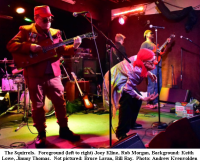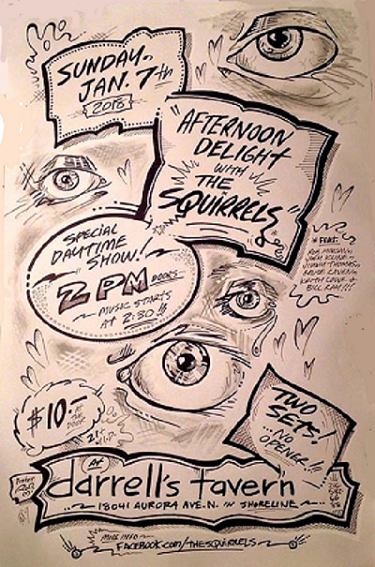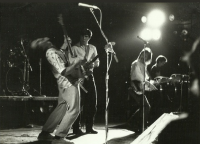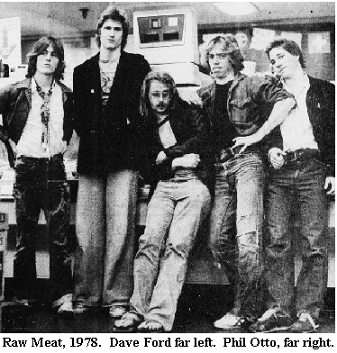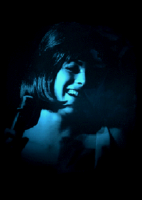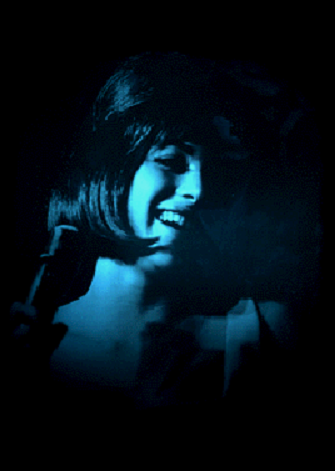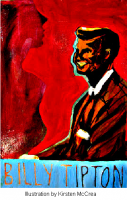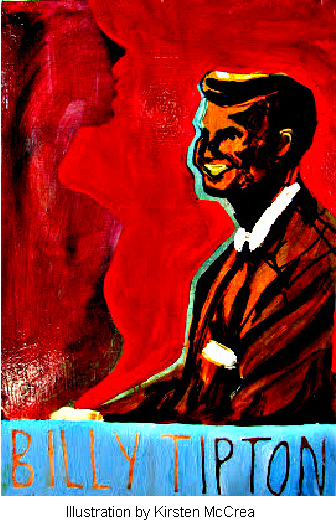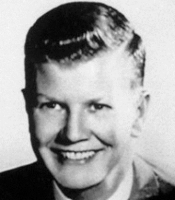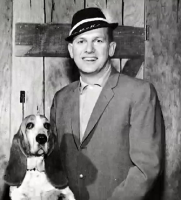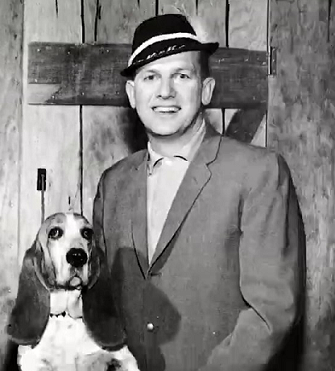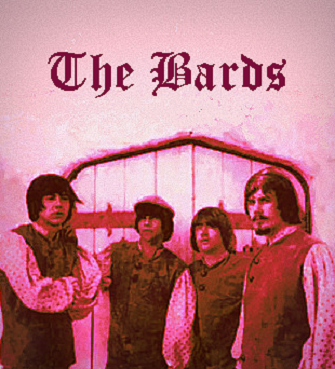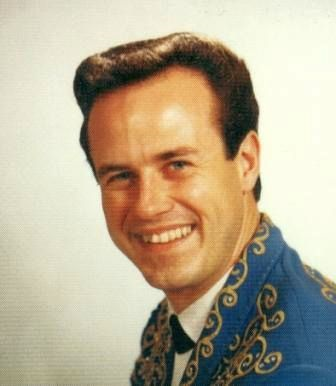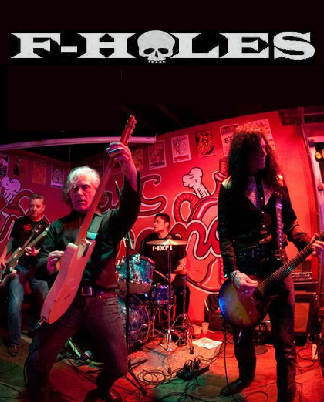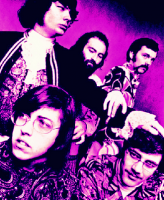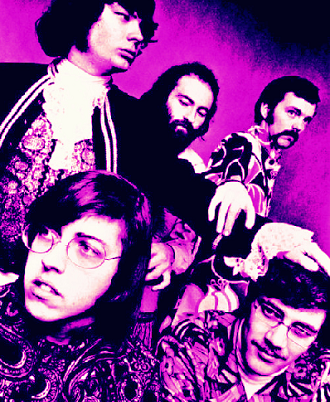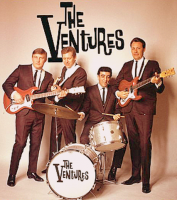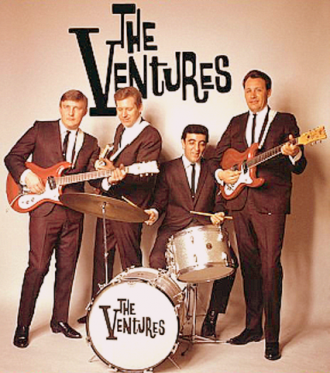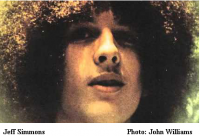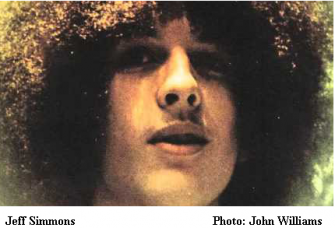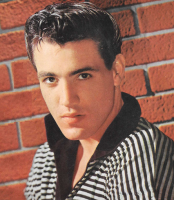
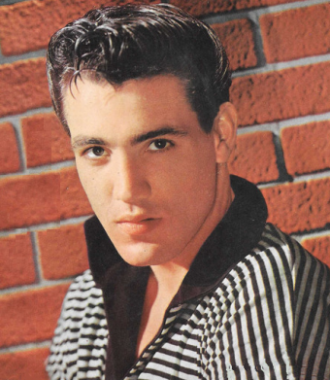 It sounds like the plot of a 1950’s film noir movie. It’s December 1st, 1967. A man leaves a party. As he drives down the San Diego Freeway in the San Fernando Valley he sees a bright light in his rear view mirror. The light gets brighter so he pulls over on a side road. He thinks maybe it’s a friend who’s also left the same party. The man in the car following him walks toward the driver’s car and the driver rolls down his window. As soon as he does, the man in the following car begins to beat him with something hard-probably a tire iron. He is left unconscious with a broken arm and a severely fractured skull. But the story isn’t the plot of a movie. The man who was beaten was Jimmie Rodgers, a fading star from the early days of rock and roll. A man that was one of the pioneers of early pop, rockabilly and electric folk music.
It sounds like the plot of a 1950’s film noir movie. It’s December 1st, 1967. A man leaves a party. As he drives down the San Diego Freeway in the San Fernando Valley he sees a bright light in his rear view mirror. The light gets brighter so he pulls over on a side road. He thinks maybe it’s a friend who’s also left the same party. The man in the car following him walks toward the driver’s car and the driver rolls down his window. As soon as he does, the man in the following car begins to beat him with something hard-probably a tire iron. He is left unconscious with a broken arm and a severely fractured skull. But the story isn’t the plot of a movie. The man who was beaten was Jimmie Rodgers, a fading star from the early days of rock and roll. A man that was one of the pioneers of early pop, rockabilly and electric folk music.
A few days later the attacker comes forward. He’is an off-duty policeman named Michael Duffy. Later Duffy would claim he pulled Rodgers over for “erratic driving”. Rodgers remembers the light was “real bright. Like a train light. I pulled over to stop. I thought it was Eddie Samuels who was my conductor. He was staying at my house at the time. Rodgers says that once he rolled down the window he was struck by a tire iron. “He hit me in the side of the head so hard, the left side of the skull, that it split the skull on the right side”.
The off-duty policeman says once Rodgers pulled over he got out of the car and during his arrest, Rodgers fell over (backward) resulting in a fractured skull and a badly broken arm and knocking him out. Duffy says he then drove to the nearest telephone and called two of his LAPD friends that were on duty, Raymond Whisman and Ronald Wagner.
Duffy says they all converged on Rodgers’ car and his unconscious body laying on the side of the road rather than inside. They decide to pull Rodgers’ body back into his Cadillac,and take off. No calls for medical assistance. No report of the incident. No mention in any of their daily log reports. No test for intoxication. No record of Duffy attempting to book Rodgers for a crime.
It was Eddie Samuels who was staying with Jimmie at the time found Rodgers bleeding in his car that night. When Rodgers didn’t arrive home as expected, Samuels went looking for him, retracing the route he knew Jimmie would have taken.
“He’d driven to my home says Rodgers. “I didn’t show up. He knew the road that I always came home on. He found me in the car. Just as he was pulling up, he saw a police car pull away. He also saw a white Volkswagen pull away behind the police car. Then he found me lying face down in the front seat of the car. He was the one that saw the police car. The guy in the Volkswagen was an off duty policeman who had stopped me, for whatever reason”.
Whisman and Wagner were charged with failing to make an arrest on arriving at the scene, and falsifying police logs. Whisman claimed that Rodgers had been gone by the time he and his partner arrived. Wagner made the same false statement in his daily field activities report. Nonetheless, Los Angeles Police Chief Thomas Reddin claimed that “investigators had been unable to establish any criminal act by the off-duty policeman (Duffy) or that he had any personal involvement with the supposed assault on Rodgers or the fractures Rodgers had sustained. Reddin added “these officers had failed to follow through with proper procedures. They know that they did wrong and admitted it”
He suspended Duffy, Whisman and Wagner for 15 days Rodgers was never formally charged for driving while intoxicated because, as Reddin said “it would not serve the causes of justice to so charge him now”. Oddly enough this incident caused the third suspension of Officer Duffy within only three years of being hired by the LAPD. He had been suspended for “ unnecessary use of force” when he’d used a blackjack on a juvenile suspect. His third was a “driving while intoxicated” conviction.
It’s clear the LAPD wanted to cover up this story and allow it fall out of the public’s consciousness as soon as possible; but it wasn’t going away so easily. Rodgers spent the next year in the hospital, went through three brain surgeries, lost his ability to talk and walk and was incapable of caring for himself, even after he was released. His convalescence took decades. While Rodgers lie in a hospital bed his lawyer filed an $11 million lawsuit against the LAPD and the City of Los Angeles for his beating by officers of the LAPD. Doctors treating Rodgers had at first concluded that his injuries were the result of a beating, but by late December had changed their opinion and that Rodger’s fractured skull to be the result of a fall…just as the three policemen (who’d falsified documents) had claimed. Clearly someone or something aside from medicine had changed their minds.
Amazingly the three officers involved in the incident and the LA Fire and Police Protective League filed a $13 million slander suit against Rodgers for his public statements accusing the three policeman of brutality. This suit never came to court, but Rodger’s case was settled with an out of court settlement years later (in 1973) for $200,000. Los Angeles County and the LAPD knew that to continue to fight Rodger’s charge would end up costing millions and Rodgers graciously accepted the meager amount of money, because he too had already spent so much pursuing his case and would probably go broke in a battle with the city of Los Angeles.
“In those days you could not sue the police department and be successful. No attorney would take the case. They just would not take a police case like that” In this case it may have been even more difficult, since the assault could have been a message from mobsters by way of the LAPD.
The entire incident-the beating and the ensuing court battles had taken a tragic toll on Rodgers physically and emotionally. Although he started to work again after two years of recuperation, it actually took about 20 years for him to completely heal. “I was lost. I was taken away from the business because I couldn’t sing anymore. It took me years to relearn to walk and talk”. At one point Jimmie’s weight had gone down to 118 pounds.
Jimmie has said that for years it was hard for him to explain what had happened to him, but eventually became able to talk about it. He mentions his faith and the determination he’d inherited from his father as crucial to his recovery. He also mentions that his Chrisianity allows him to forgive what was done to him even though he is mystified why he was attacked so brutally.
Others are not so forgiving, and not so mystified why an attempt on Rodger’s life happened. In his 2011 autobiography .Me, the Mob, and the Music Tommy James (of Crimson and Clover fame) confidently states that the attack was a mob hit choreographed by Morris Levy, the president of Roulette Records It also included corrupt officials in the LAPD and The Medical Examiner’s Office. Jimmie Rodgers had recorded with Roulette between 1957 and 1960. James also recorded for Roulette and claims that Rodgers had been seeking to recoup royalties from the millions of records he’d sold-and never been paid for. It’s said by the time Rodgers left Roulette he was owed about $1.5 million. That would be $12.405 million in today’s money. At the time of Rodger’s leaving Roulette, their books claimed they had spent $26,000 on him and paid him $20,000….leaving Rodgers owing Roulette $6000. This was the kind of outrageous way Levy ran Roulette Records. It was almost wholly a criminal enterprise. This was the mileu Jimmie Rodgers had unknowingly gotten himself into..
James Frederick Rodgers was born on September 18, 1933 in Camas Washington, a small town just north of Portland Oregon on the Washington side of the Columbia River. Both of James’ parents worked for the Georgia-Pacific pulp mill that at the time dominated the working-class community. James too would work there in order to pay for his time in college. Jimmie has said that he had never taken a music lesson in his life, but if that’s so, his mother would have been a very strong influence on his abilities. Aside from work at the pulp mill Jimmie’s mother was an accomplished guitarist and piano player who did ocasional tutoring. She also had played organ and piano to accompany silent movies as a young woman. His mother was a devout Christian, a faith she instilled in her children. It was this faith that Jimme later said pulled him through the darkest days after his 1967 beating.
James was brought up in a typical mid-century household that seems to have been fairly happy, but one thing he lovingly remembers his father, saying;
“My dad was a tough guy, They called him “Tuffy”…he was a little Irish guy. He would never let my brothers or I complain about anything. If we went fishing and we said we were cold he wouldn’t take us fishing anymore. One time I had a big decision to go on a television show or something. My dad never gave me any instruction at all. When I asked my father about what I should do in that situation, him being a fighter said keep your right hand high and your ass off the floor”. He laughs. “That’s the only thing my father ever told me to do”
It’s been speculated that Jimmie’s name became spelled with an “ie” rather than the more common “y” by his mother. Their last name was spelled as the lesser-used “Rodgers”….like Jimmie Rodgers the father of country music. Jimmie’s mother was a fan of the “Yodelling Brakeman, who had died the same year her son was born. Rather than calling him the more formal “James” the family used the more easy-going “Jimmy” It’s also thought that she chose the spelling “Jimmie”-after Jimmie Rodgers.
In 1951 Jimmie graduated from Camas High School and went on to spend a year studying engineering at Clark College in nearby Vancouver Washington. In 1952 Jimmie put college aside and joined the United States Air Force. Since he had been taught how to use a rifle growing up, and was fairly proficient he ended up training other recruits in shooting.
In a 2015 interview with Dr. Roman Franklin (a/k/a Doctor Doo-Wop) Jimmie talked about his time in Korea.
“I was in Korea teaching weapons just off the front line so it was pretty rough. Back in the Quonset hut at night we’d sing and drink beer because there was nothing else to do. There was a couple of kids that could sing pretty good and they’d and sing from the behind me and they really had that black rhythm feel. I wrote a song “The Woman From Liberia” from the Bible-the story about the woman at the well, but I didn’t want to name it after a story in the Bible. I wrote the song and I started playing it sitting on the foot locker, playing it alone with an open chord strum on my guitar and playing it at that tempo, and they’d back me.that could sing pretty good and they’ sing behind me and they really had that black rhythm feel. I started playing it sitting on the foot locker, playing it alone with an open chord strum on my guitar and playing it at that tempo, and that’s tough-every time you change keys it’s really tough. By the time you hit that high note at the end your tired.
“So these kids would sit with me and sing. I didn’t have a recorder or anything and when I finally got back to America I lost track of them. I didn’t even know their real names-just their first names, but later I recorded that song because I felt like doing it. It’s a cool song. It’s really fun to listen to.
As an aside; Jimmie refers to his black co-airmen as “kids” not out of disrespect, since he always referred himself and his fans as “kids” He still uses the term occasionally as a term of inclusion rather than as a veiled epithet.
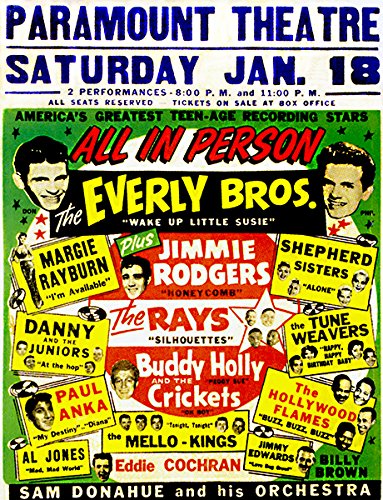 Jimmie may not have ever seen his singing buddies from Korea again, but there was at least one incident of meeting a fellow black servicemen when he got back stateside. He was assigned to Sewart Air Force base at Smyrna Tennessee, Rodgers had a chance meeting with one of his black wartime buddies in the mess hall. They hugged, laughed and pounded each others backs. A Staff Sergeant snarled aloud at seeing this white airman “hugging a nigger,” Rodgers pounced on him, beating the larger man into submission. Several other soldiers pulled him off the Staff Sergeant Airman 2nd Class Rodgers pulled extra duty for a month “I never did learn how to handle prejudice,” he admitted to biographer Will Ruha.
Jimmie may not have ever seen his singing buddies from Korea again, but there was at least one incident of meeting a fellow black servicemen when he got back stateside. He was assigned to Sewart Air Force base at Smyrna Tennessee, Rodgers had a chance meeting with one of his black wartime buddies in the mess hall. They hugged, laughed and pounded each others backs. A Staff Sergeant snarled aloud at seeing this white airman “hugging a nigger,” Rodgers pounced on him, beating the larger man into submission. Several other soldiers pulled him off the Staff Sergeant Airman 2nd Class Rodgers pulled extra duty for a month “I never did learn how to handle prejudice,” he admitted to biographer Will Ruha.
Skin-based hatred made no sense to him. Ruha explains; “Such stupidity was anathema and intolerable, even if defending a friend meant month-long military reprisal. Even among the staunchest of southern racists, Rodgers signaled a message of moral courage and egalitarian defiance: beneath the skin we all bleed red. The kid with the guitar had guts”.
Rodgers’ reaction to discrimination fell squarely within the lessons he’d learned from his mother and the church. It also fell squarely into the ideals of the folk music he loved so much. Folk music was blind to color or ethnicity. It’s roots lie in traditions from all cultures, all around the world.
While stationed at Sewart AFB he began singing in Nashville. In 2015 he said;
“I was working in bars-playing and singing in Nashville Tennessee. I was working in a little place in Printers Alley called “Club Unique”. I’d work about six hours a night…ten dollars a night and free drinks. Then I’d play guitar and sing. When I was working there the people that owned the place (Bob and Bobbi Green) said ‘there’s a song we’d like you to hear’ They had it at home so I went over there and I listened to it. It had been recorded by Georgie Shaw in 1954 and they taught me how to play it. I sat on the floor and learned it right there, and then in that little nightclub I’d play it every Friday or Saturday night during prime time…probably a dozen times and people liked it”
Although Georgie Shaw’s version of “Honeycomb”, the song the Greens had recommended, was largely ignored when it was released it had a good pedigree. It was written by George Merrill. Merrill wrote songs as diverse as “How Much is That Doggie in The Window” for Patti Page to “People” for.Barbra Streisand. Merrill went on to write and produce some of the most popular musicals and songs of the 1960s and ‘70s and garnered eight Tony Award nominations.
After being discharged from the Air Force in 1956 Jimmie returned home to Camas Washington. He found work in small clubs around his hometown, in Portland and throughout the Northwest. For awhile he was living out his 1948 Buick. Then he began to seek work up and down the west coast and eventually ended up in Los Angeles where he auditioned and appeared on CBS’s Art Linkletter’s House Party show in 1956. Once back home he began playing at The Fort Café in Vancouver Washington One night Chuck Miller-who’d had a big hit with Mercury Records called “The House Of Blue Lights” walked into the club. He listened to Jimmie and encouraged him to set up an audition with Roulette Records in New York City. At the time Roulette was an affiliate of Mercury. Much to Jimmie’s surprise, Miller was actually able to put in a good word for him.
“When I got out of the service me and my wife drove my old car to New York thinking ‘I’m gonna make it big’ and of course no one in any night club would listen to me. So I went to Roulette Records, which was then a little place on 10th Avenue. I was trying to get enough money to get out of the hotel I was in, I didn’t have the money to pay them” he laughs” I played that song (Honeycomb) and the Roulette guy says to me ‘where did you get that song?’ I told him”
They had already taken notice of Jimmie, both from Chuck Miller, but also from an appearance as a contestant on The Arthur Godfrey Show in a talent contest on the radio. Jimmie won $700 by performing “The Fox and the Go
They signed him on the spot.
“I went into a studio a couple of days later called Bell Sound” In those days Bell Sound was a small two track-four track studio, which at the time was state-of-the-art and used by many successful singers.
“I did that song in an hour and they had three or four people I didn’t know. I had no manager there. My wife was sort of sick back at the hotel and she couldn’t come over. After I finished I went outside to smoke a cigarette and they closed the closed the door and I couldn’t get back in. So I was knocking on the door out there and the red light was on. They thought I had gone home because I was so shy. I didn’t have any money because I’d taken a cab over there, so I had to walk several miles back to the hotel at night with my guitar and little amplifier. I wanna tell you” he adds “ I didn’t know what I had done, but when I got to the hotel I told my wife “I did something pretty good”.
“So to make a long story short we had the money to go home really soon because I’d made some money in New York. We drove my old Buick all the way back to Washington State. One day I’m outside washing the car and they played “Honeycomb” on the radio”. Jimmie recalls.
It became the first of a run of hits Jimmie Rodger’s cut for Roulette between 1957 and 1960. His debut single would become his biggest hit, charting at number one for seven weeks on the Billboard Top 100 in 1957. “Honeycomb” also reached number one on the R&B Best Sellers chart and number seven on the Country & Western chart. It was followed by a succession of hits. Those included “Kisses Sweeter Than Wine”, “Bimbombey” and “Are You Really Mine?” Jimmies’ career eventually included more than 450 songs-40 of them being top ten hits. He made hundreds of television appearances, had his own TV show and sang the theme song for 1958’s “The Long Hot Summer” starring Joanne Woodward, Orson Welles and Paul Newman. Angela Lansbury and Lee Remick were also featured. The film was a huge success and garnered Paul Newman a Best Actor Oscar. Jimmie played his song from the film at that year’s Academy Awards. He admits he “was scared to death”
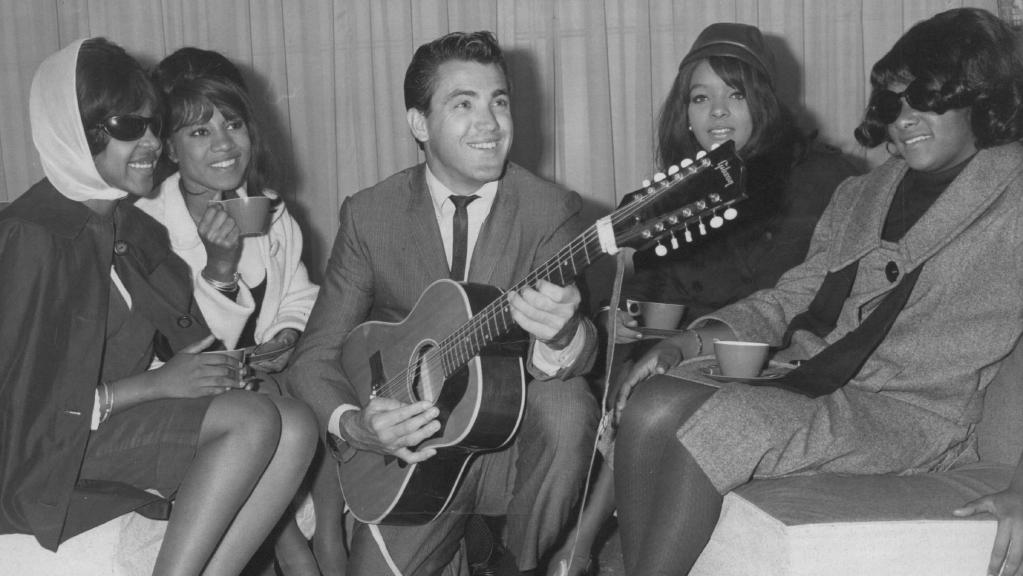
Jimmie Rodgers with The Crystals at Mascot Airport, Sydney Australia during their 1964 tour Down Under.
Jimmie’s screen debut as an actor came in 1961 with “The Little Shepherd of Kingdom Come’ His next role was in 1964 in “Back Door To Hell” co-starring a young Jack Nicholson. Neither did very well at the box office, but today “Back Door To Hell” is considered a classic of it’s genre-the WWII action drama.
He was also part of several Allen Freed’s and Dick Clark’s all-star touring shows with The Everly Brothers, LaVern Baker, Chuck Berry, Bobby Darin, Buddy Holly and others. He became good friends with Buddy Holly since they usually roomed together while on tour. Jimmie was not used to live performance and the audience reaction of screaming above his voice irritated him. He told Buddy how unhappy he was with the tours and had decided to quit. Holly told him how important it was to continue, He was persuaded by Holly to remain. After his good friend died, Jimmie committed himself to performing live in Buddy’s honor.
Despite his success with fans across the world, he had to work hard selling himself to promoters.
“I was never recognized as a “pop” singer….I was a folk singer…But they (the promoters) didn’t want that. I worked with Johnny Cash and people like that, but I wasn’t country. It wasn’t really pop so much. Dick Clark didn’t know what to do with me because I really wasn’t rock and roll. He really didn’t like it that much”
When Jimmie signed with Roulette Records the label gave their artists a great deal of creative control. The downside was that the label hardly ever paid them. The company was run by Morris Levy who had known ties to organized crime and Roulette was a money-laundering front for the Genovese family; one of the five mobs that ran of New York’s crime syndicates.. Despite the “downsides” Jimmie speaks fondly about his time in the studio while at Roulette
“Roulette Records was very smart. They had good producers (Hugo Peretti and Luigi Creatore) and knew how to work in the studio. They let me just sing. I’d have a small glass of black brandy to clear my throat. I never warmed up my throat. I didn’t do hours of warm-up. I never had to”
“The technology then wasn’t like it is now. We used to mix a little on the edge of the recording so it stayed on the edge of the vinyl. When you do that the sound comes out a little more on the top edge instead of the bass. Of course that vinyl would wear out more quickly, but now that you digitize it It’ll come back with that sound. I would listen to the mix as much as I could and I would sit-in on the mix as much as I could”.
“I would take a little tiny four-inch speaker and maybe a six inch speaker and set it on each side while we were working and bring the level down and put it right against your chest, right off the board so it would hit you right in the chest like your driving a car. I would mix on little car speakers and nowadays they mix on these huge speakers and I think it’s wrong because you get the normal sound’
Listening to mixes on crummy speakers is a trick that’s been used by producers, engineers and artists for a few decades. During the golden age of Top-10 Radio it was presumed most hits would be heard on car radios or poor quality consumer audio (hi-fi) players. It seems that Jimmie and his producers Hugo and Luigi had caught onto this technique earlier than most. These were singles created for fans, not audiophiles.
As for Morris Levy; Steve Kurutz of allmusic.com reports a contemporaneous record executive calling Morris “a notorious crook who swindled artists out of their owed royalties.” Levy’s birth name was Moishe and members of the record business called him that name. In a jazz-themed issue of Playboy it was written that “He is called Moishe by friends – and other one-syllable names by enemies.“. Levy was both respected for his business acumen and feared because it was no secret his success was the result of working with mobsters.
Levy had been born in The Bronx but moved to Brooklyn shortly after his father Simon died of pneumonia. He quit school at the age of 13 after assaulting a teacher over what he considered an unjust order to re-do a math test that most of the class had failed-Morris himself had passed the test, but was also expected to take it again. He later said:
“She looks at me and says ‘Levy, you’re a troublemaker. I’m gonna get you out of this classroom if I have to take your family off home relief’ And I got up-I was a big kid-and took her wig off her head, pouted and inkwell on her bald head and put her wig back on her fucking head. Walked out of school and said ‘Fuck school.’ Never really went back to school after that. I was sentenced to eight years to reform school by the children’s court…The bitch had no fucking humanity” .
Levy says that after the incident he ran away to Florida to avoid a sentence in Juvenile detention. He ended up working in mob-owned clubs first as a hatcheck boy and later as an assistant, developing photos for professional photographers who took pictures of customers in the clubs, developed them and sold them back to the customers before they left. Both were lucrative jobs that could be done while skimming undocumented cash off the top.
After spending five months in the Navy Morris received an honorable discharge based on his mother’s failing health. He returned to Miami and became more involved in the hatcheck rig which was a favorite of crime families to enter their ranks. Skimming the proceeds from jukeboxes was also popular.
Levy convinced some of his “bosses” to buy a jazz club in New York City called “Topsy’s Chicken Roost”’ at 1580 Broadway. It was a prime location for what he had in mind. Levy would manage the club for a “finders fee” which included a piece of the club itself as well as a cut of the lucrative hatcheck proceeds. He partnered up with a man named Ralph Watkins. Watkins had been a jazz promoter since the 1930s and had ties to a myriad of jazz artists and their managers. So Levy and Watkins changed the name to “The Royal Chicken Roost” and later dropped the “chicken” altogether. Levy took care of “business” and Watkins did the booking and promotion.
Soon the club was hosting be-bop greats such as Dexter Gordon, Miles Davis and Charlie Parker. The Royal Roost became so closely associated with bop that it became known as “The Metropolitan Bopera House” and “The House that Bop Built.“.
In his 2016 essay “The Royal Room; The Birthplace of Bop”. Richard Carlin writes;
“Things were going very well at the Royal Roost by 1949: so well that Levy and Watkin’s apparently started to look for a larger space. According to Levy, Watkins failed to cut him into the new deal which involved opening a lavish new restaurant/night club on the second floor of The Brill Building at 48th and Broadway, to be called Bop City. Although significantly larger and more expensive to operate (rent alone was quoted as being $35,000 a year), Bop City mirrored the unusual admission policies and seating arrangements of the original club”.
This left Morris Levy to manage the Royal Roost, but he had bigger ambitions. In 1949 he found a small space on Broadway named The Clique. Levy rebranded it “Birdland” in honor of Charlie Parker whose nickname was “The Yardbird”. Eventually Parker became known simply as “The Bird”. Although the club only held about 400 patrons, it went on to become the most important jazz venues of all time. Birdland was known for astonishing performances by the word;s best jazz players. This did not mean Birdland was above open mob violence. In 1958, a man was gored to death with a piece of broken glass in the Birdland doorway. The crime went unsolved. Two weeks later Morris’s older brother, Irving, was killed at Birdland while Morris was off-duty.. The murder was said to be prompted by Morris Levy’s “business” connections. According to news reports, the suspects were described as a balding former convict and his wife, who has been convicted of prostitution.. The two were held without bail Saturday in the slaying of an assistant manager at Broadway’s Birdland. They were charged with the knife death of Zacariah (Irving) Levy, 36, at the Birdland club last Monday night.”
Kliph Nesteroff, wrote an essay on the WFMU blog called “Mobsters, Scoundrels, Comedians and Rat Finks” In it he reports
“A few years later during a heated argument with a client, Morris intimidated his opponent, lecturing, ‘Do you know what I did to the bum who killed my brother? I fucking took a knife and stuck it in his fucking stomach – and I twisted it. I stuck it in his fucking stomach until his guts fell out.”
Author Steve Kurutz wrote about Levy being approached by a representative of ASCAP and told he must pay the publishing company a monthly stipend for the privilege of booking live music.’
Levy himself said
“A guy comes in from ASCAP and said he wanted money every month. I thought it was a racket guy trying to shake me down. I wanted to throw him out. And then he came back again and said he’s going to sue. I said, ‘Get the fuck outta here.’ I went to my lawyer and I says, ‘What is this guy? He keeps coming down, he wants money.’ My lawyer says, ‘He’s entitled to it. By act of Congress, you have to pay to play music.’ I said, ‘Everybody in the world’s gotta pay? That’s a hell of a business. I’m gonna open up a publishing company”.
Levy may not have known about publishing at the time, but he saw it as a way to increase his profit, so soon he’d set up his own publishing business. Patricia Publishing, with a view to acquire as many copyrights as possible. It wasn’t long before Levy learned how to manipulate the business to his own favor. Nesteroff adds that Levy demanded the rights to “all songs first performed in Birdland, including the venue’s soon-to-be-famous Lullaby of Birdland. Morris amassed his royalty money and received a substantial loan from Thomas Eboli of the Genovese crime family. He had used the money to open Birdland. Always the confidence man, Levy’s publishing company had a propensity for ludicrous claims. When Roulette artist Jimmie Rodgers recorded an album of Christmas songs, Morris Levy was listed as the composer of Silent Night.”
Levy was also engaged in adding his name (or a pseudonym) as a writer’s credit in order to collect some of the royalties for himself. He hung onto his false songwriting royalties while refusing to hand out what was rightly due writers and artists, and often bragged how successful he’d become because of the practice.
Since the music business was essentially run by the mob, and Roulette having direct ties it’s not surprising that the label was a success out of the box. One of its first signings was Frankie Lymon and The Teenagers, in 1956. In 1955, The Teenagers (at that time calling themselves The Premiers) auditioned “Why do Birds Sing So Gay?” for producer and owner of Gee Records, George Goldner. The group’s tenor, Herman Santiago, had written the song. He’d come across a letter that featured the words “Why do birds sing so gay?,” which fit in with the lyrics he’d been writing. It became the working title of the song.
The harmonies were tweaked to take advantage of Frankie Lymon’s high tenor/soprano voice. During the audition for Goldner, Frankie’s voice stood out, so Goldner advised the band to give Frankie all lead vocals. Frankie did some of his own tweaking of the melody of Why do Birds Sing So Gay?” to match his voice and delivery.. According to Jimmy Merchant, “what happened at the recording session was a combination of Frankie’s singing ability coupled with George Goldner’s special ability to bring out the best in Frankie”.
Although “Why Do Fools Fall in Love?” original release on Gee Records credited Frankie Lymon, Herman Santiago, and George Goldner as co-writers later releases and cover versions were attributed only to Lymon and Goldner. Morris Levy dropped Golder’s credit and added his own name as a co-writer when he bought out Gee Records and re-released The Teenagers song on Roulette Records. It reached Number one on the R&B chart, Number six on Billboard’s Pop Singles chart, and number one on the UK Singles Chart.. Levy made sure he controlled the publishing and himself as one of the songs writers.
Later, in 1981, after Diana Ross had a top ten hit with “Why Do Fools Fall in Love” a major controversy concerning Lymon’s estate ensued. Zola Taylor, Elizabeth Waters and Emira Eagle each approached Levy as being the wife of Lymon, although Taylor had not divorced her previous husband before marrying Lymon. Lymon then married Waters, but neglected to divorce her before marrying Eagle. The saddest part of course was that Lymon had famously been found dead on the floor of his grandmother’s bathroom after a heroin overdose in 1968.. He was only 25 at the time.
A lengthy court battle ensued and songwriting credits were awarded to Teenagers members Herman Santiago and Jimmy Merchant in December 1992. In 1996, the ruling was overturned by the Court of Appeals because the and authorship had run out due to the Statute of Limitations. Santiago and Merchant had not brought the case to court earlier This decision gave the song rights back to Lymon (who had famously died in in 1968 of a heroin overdose) and Morris Levy Since Lymon left no legal heirs 100% of the copyright reverted to Levy.
Jimmie Rodgers would also find that the royalties illegally withheld from him for his years at Roulette would also fall outside the Statute of Limitations when he sought to recover them… even though it was charged that Levy had engaged in fraud, and had even gone so far as to re-release and license Rodgers’ music even after Rodgers had left the label.
After Jimmie Rodger’s beating his career seemed to have ended. He went from one of the most visible people in the US to obscurity. He’d had several modest hits since leaving Roulette-most of them were for Dot Records, where he also wore the hat of producer, head of A&R and director of Folk Music Dept. He remained at Dot until the mid to late 60’s. Shortly before his assault he’d signed with A&M Records and seemed to be headed toward a come-back with the release of “Child of Clay” which became his last charting hit, peaking at number 31 on Billboard’s Top 100.
He’d also written the song “It’s Over” in 1966. It would prove to be his most covered song, with renditions by Glen Campbell, Dusty Springfield (both in 1967), Elvis Presley (1973), The Sweet Inspirations (2006) as well as a multitude of other notable stars. In fact many of his compositions have become standards that have been recorded by many artists in many diverse genres. One presumes that he receives his songwriters’ royalties from these recordings.
Eventually it was fans that would come to him rather than the other way around. He began to show up on television, do live performances. The audiences weren’t as large as the 84,000 he’d played for at Chicago’s Soldier Field in April of 1958. They had not forgotten all of his hits, his appearances on Dick Clark’s Bandstand, The Ed Sullivan Show (three times), Perry Como, His poignant version of “Waltzing Matilda” used in the classic film “On the Beach” his playing the theme from “Long Hot Summer” at the 1958 Academy Awards, the all-star tours and his personal appearances. So Jimmie began touring again. Because of the change in tasts of music by the mid-60s Jimmie Rodgers became less of a “pioneer of rock and roll” and thought more of an “adult-contemporary” artist-nearly a death sentence for most artists-but he continued and eventually was able to put together world-wide tours in sold-out venues. Even though he tried to avoid the “oldies circuit” claiming he didn’t want audiences to think he hadn’t done anything after 1960, he finally relented. It was during this period that Jimmie would face the second greatest blow to his career.Spasmodic Dysphonia, a vocal ailment that affects the nerves and muscles that control the larynx.
During a tour of Australia and New Zealand he started having difficulties with his voice. The day of his opening night in Aukland he told his wife Mary that he was having problems wheezing and coughing. He went on stage anyway. Jimmie recalls he tried to sing “Honeycomb”
“At first air would come out and then the voice would catch. I worked for an hour with that voice and I struggled all the way through. When I came off I said “I don’t know what’s wrong”. I got up the next day and it started again. I finished the tour but it was very difficult and by the time I got home I couldn’t even talk”
Though he’d completely lost his voice, but he sought an answer and went through several voice instructors. Eventually he was diagnosed, even though it was unclear what had caused it. At one time doctors and researchers thought it may have been caused by a virus. Some think it’s the result of an injury. It’s hard to wonder if his beating was the cause of his Spasmodic Dysphonia, but the truth is, it could have been caused by a number of things. Medicine has never found it’s cause nor it’s cure. Over the course of years of practice, determination and faith his voice partially returned. It ended his career as a singer, but not as a performer. In 2010 he said:
“Before I talk on the phone I have to clear my voice. If I go to talk to somebody in a crowd they can’t hear me. I can’t do it. I can’t go to dinner and sit and carry on a conversation. I’ve had it ( Spasmodic Dysphonia) now for 40 years and there’s no cure for it. There’s a lot of people working on it now, but nobody really knows what it is or what causes it so I’ve had to live with that. Like I said for awhile nobody would book me. They think this guy can’t sing anymore but he can perform.Well that’s not true. I’m doing a great show and there’s people out here who want to hear Jimmie Rodgers, and people who want to book Jimmie Rodgers. I want to work and this is the time in my life that I think I sing better than I ever have”
Now in his later years (he’s 85) he still performs from time to time. He uses a twist on a technique that’s become all too common in today’s music business. He does a great performance but uses tapes of his voice and sings over them. The difference is that Jimmie is open about it with his audience. He tells him what he’s doing, about his ailment and invites them to join in.
In many ways Jimmie Rodgers is a Renaissance Man. In his Dr. Doo-Wop interview he said
“I’m writing every day. I get up 6:30 every day and I’m writing to noon at at least to noon. I’ve written three animated features. I’m also writing screenplays. I read a lot..I’m really kind of a hermit. I’ve been married 35 years. My wife is a retired ballerina and dance instructor, and I teach golf. I’m a certified golf teacher on the side”. He says in his 70s he was running 10 kilometers a day. Now he only does it every other day. Jimmie has also written his autobiography, ‘Dancing On The Moon’ and a screenplay for its motion picture adaptation. It’s been described as
“ a highly charged emotional autobiography, detailing the savagery of the recording business, his brutal beating by an off-duty Los Angeles policemen and many other answers to “What Ever Happened To Jimmie Rodgers?
Jimmie’s bio calls ‘Dancing On The Moon “’A true story that is uplifting and yet tragic as it describes his journey through the Mafia power of some of the music business to the high road of success that can changes lives”.
For the time being Jimmie and his wife Mary stay busy around their Palm Springs home, and make regular trips back to Camas as well as Seattle where he maintains his management. In 2013 he made one of his trips to his hometown to have a street named after him. On September 13th NW 10th Avenue became Jimmie Rodgers Avenue. His hometown paper, The Columbian reported that as a kid Jimmie “would take his soapbox racer to the top of the hill and zoom down it like hell on four wheels. Even as a youngster, Rodgers knew there’d be one of two outcomes on that street.
“I’d either get killed on this street,” Rodgers said with a chuckle, “or I’d have my name on it.”
Morris Levy’s life did not end on such a high note. After a 3 ½ year investigation by the FBI a case was levelled against Levy for the extortion of John LaMonte, a record wholesaler from Darby, Pennsylvania. LaMonte had agreed to purchase records valued at $1.25 million in a 1984 deal. He subsequently refused to pay the full price, claiming that the best titles had been removed from a 60-truck delivery. It was claimed that Levy extorted the money from him and LaMonte received a fractured eye socket along with the deal. Levy had sold Roulette Records and his publishing rights for $55 million during the investigation. The FBI knew Levy had long used Roulette Records as a front for Vincent Gigante and the Genovese family. Now they were able to prove it through covertly recorded conversations and wiretaps of Levy and of Gaetano Vastola, part owner of Roulette.
During its investigation, the FBI determined that Levy had used the Roulette as a front for the mob. Much of the trial evidence came from covertly recorded conversations taken from wiretaps and listening devices planted in the phones and business offices of Levy and Gaetano Vastola. After Gaetano’s conviction for his part in the extortion of John LaMonte he became a cellmate of another notorious criminal, John Gotti. Gotti was convinced that Gaetano would turn state’s witness in the case and he would be caught up in it. When Gotti was released, he pressured New Jersey’s DeCavalcante family boss John Riggi to murder Gaetano. The FBI were able to catch wind of the plot.. In the end Gotti and the DeCavalcante leadership, including Riggi and Stefano Vitabile (another mobster) were tried and convicted of conspiracy to murder Vastola.
Morris Levy was convicted in December 1988 by a Federal jury of two counts of conspiring to extort the money from LaMonte. Others were convicted, along with Roulette’s controller Howard Fisher and Dominick Canterino who was part of the Genovese crime family. The FBI also testified that Levy had also been a major supplier of heroin for a Philadelphia drug dealer, Roland Bartlett. Levy was sentenced to ten years in prison in 1988 and fined $200,000. Levy appealed his conviction. Canterino was sentenced to 12 years in prison, and Lamonte did indeed testify for the state. He then entered the federal witness protection program.
While he was awaiting his appeal Morris Levy was free on bail, obviously through money he’d stolen from many of the Roulette artists. In October of 1989 Levy’s conviction was upheld by the United States Court of Appeals in Philadelphia. In January 1990, Levy’s lawyers petitioned to have his sentence eliminated because of his failing health. It was rejected, but he was granted a 90-day stay. He was scheduled to report to prison on July 16, 1990 but died on May 20, 1990 after a long, painful battle with cancer.
For all the ups and downs in Jimmie Rodger’s life there has been poetic justice. He’s lived through corrupt cops, dishonest business dealings, beatings, mobsters, lean times and ill health yet it could not stop him. Instead he has lived a long life, found success, lost it, then regained it. He has worked despite the Spasmodic Dysphonia that took his voice from him. He loves his wife dearly and enjoys his life far more than he could ever have imagined as a kid in Camas Washington. It’s hard to look at his life without considering the advice his father had given him years earlier:
“Keep your right hand high and your ass off the floor” his father Tuffy told him. “I don’t quit”says Jimmie. “I don’t know how to quit. Nobody ever told me how to quit”
-Dennis R. White; Sources-Gary James “Interview with Jimmie Rodgers (www.classicbands.com, retrieved January 6, 2018); Dr. Doo-Wop “Jimmie Rodgers Interview” (June 4, 2014); Troy Lennon “The Mystery of Jimmie Rodgers’ Bashing” (The Daily Telegraph



